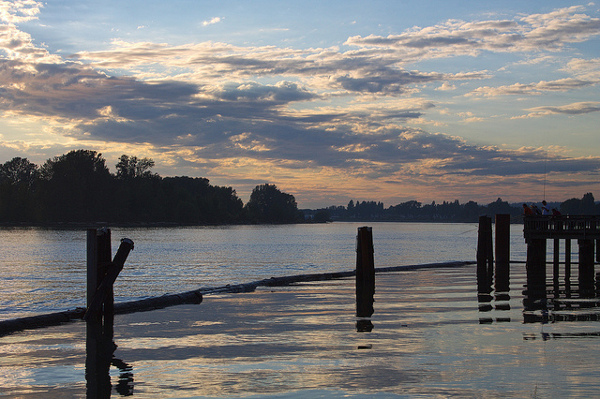B.C. Premier Christy Clark has made it a condition of her support for heavy oil exports that project proponents and federal agencies ensure "world-leading" marine and land-based spill prevention, response and recovery. What would those systems look like in an active earthquake zone?
A new seismology study published Monday carries direct implications for pipeline construction in British Columbia's Lower Mainland. Twenty years after a serious oil spill blackened the Santa Clara River in California, the report invites reflection on what "world-leading" protection would cost along the Fraser River, and what it could require of engineers.
On Jan. 17, 1994, the Northridge earthquake struck the San Fernando Valley in southern California. The shaking began at 4:31 in the morning. Freeways and apartment buildings collapsed, killing 57 people and injuring thousands. Buried out of sight, an old pipeline operated by the Atlantic Richfield Company tore apart at the seams. Welds failed at nine different points along a 56km stretch, including at a pumping station on the banks of the Santa Clara.
Coast Guard commander Thomas Leveille reports what happened next: "The oil flowed across the parking lot, into a storm drain, then into a drainage ditch to the Santa Clara River." In total, 190,000 gallons poured into the wide, shallow waterway, which was running that night at about gumboot depth. ARCO workers discovered the spill at 5:35 AM, alerting government officials two hours later. As ambulances raced to help victims of the earthquake, cleanup crews scrambled downriver to stop the flow of oil.
"Initial response efforts were hampered by several earthquake-related problems," writes Leveille. Closed roads and broken communications infrastructure slowed everyone down. Booms were eventually pulled across 25km down from the pumping station, halting the slick. Over the days that followed, a crew of more than 500 people vacuumed crude out of the river and catalogued dead animals: "4 mammals, 10 amphibians & reptiles, 59 birds, and 650 fish." Then they got to work digging out 100 acres of contaminated vegetation along the riverbank.
ARCO settled three years later with the California Department of Fish and Game, paying $7.1 million for restoration costs, on top of "many tens of millions" spent by the company in the aftermath. "Cleanup of the river included removing oiled vegetation, excavating soil and sediment, backfilling, and grading of the river bed," according to a 2002 environmental assessment. In total, 150 acres of the river bottom was replaced. Twenty years later, the plant and animal life has mostly returned.
"It's very close to fully recovered," says Ron Botorff, a retired aeronautical engineer who chairs the non-profit Friends of the Santa Clara River. "We've done sampling and haven't found any residual oil. What they didn't get would have been washed out in a major flow." In heavy rainfall, the foot-deep creek swells to a raging torrent. Botorff says it's lucky the river stayed shallow while crews built an earthen dam, containing the damage. "The worst effect would have been if it made it all the way to the estuary".
The Trans Mountain pipeline has run through the Lower Mainland for 60 years, with a mixed record of leaks and spills. In December, Houston-based Kinder Morgan submitted a proposal to build a second, larger pipeline, closer to the Fraser River. Both would cross into Coquitlam near the Port Mann bridge, in tunnels drilled beneath the water. "If it's in an area that is subjected to major earthquakes," says Ron Botorff, "I would say that's a very questionable idea."
The Big One
Geological evidence suggests that every 300 to 900 years, the subduction fault off Vancouver Island lets go, producing a large "megathrust" earthquake and associated tsunamis. Wave records in Japan corroborate First Nations oral history, pinpointing the date of the last Cascadian subduction quake: January 26th, 1700. That event had an estimated magnitude of 9, and the waves wiped out whole villages. Three centuries later, seismologists say we've entered the window for the next "Big One".
On Boxing Day in 2004, a massive earthquake hit off the coast of Sumatra, sending waves up to 30 metres high crashing through coastal communities. At least 230,000 people died. Struck by the similarity of the subduction zone in the Indian Ocean, seismologist John Cassidy at the Sidney office of Natural Resources Canada began plugging data from the Sumatra quake into computer models of the B.C. coast. “The Boxing Day images were a graphic reminder of what can and likely will happen in the future," Cassidy told Canadian Geographic. "The key is to use the information and learn from it.” One thing his simulations showed was tsunami waves, zooming up the Strait of Juan de Fuca.
Tankers leaving the Kinder Morgan terminus in Burnaby currently sail that route at a rate of five per month. Under the proposed expansion, that number would increase to 408 return trips per year. On average, that's more than one full oil tanker every day. The operational lifetime of the Trans Mountain pipeline may only be a few decades, and the "Big One" might not happen in that time. But subduction quakes are not the only kind to strike the Pacific Northwest.
In a new report covered by The Tyee, UBC seismologist Sheri Molnar looks at the scenario of a shallow "blind-thrust" earthquake closer to Vancouver, originating a few kilometres down in the earth's crust. By coincidence, Molnar and her co-author John Cassidy based their models on the 1994 Northridge earthquake in California -- the one that destroyed the ARCO pipeline. The results of their simulations are surprising.
Molnar and Cassidy found the bowl-like shape of the Georgia basin would likely amplify seismic waves, producing longer periods of shaking and greater ground movement than previously predicted. "If it occurred 50-80 km from Vancouver, on the other side of the basin," says Molnar, "that would cause the greatest ground motion in Vancouver." She hopes her research can be helpful to engineers. "Our results are important for very tall structures or long structures, such as a pipeline."
Quake-proof design can cost billions
Engineering solutions do exist to protect pipelines and oil tanker terminals from seismic activity. On a November afternoon in 2002, a magnitude 7.9 earthquake rocked the Denali fault, which is crossed by the Trans-Alaska pipeline. "Due to a rigorous design which took into account seismic activity similar to the 2002 Denali earthquake, the pipeline withstood the ground movement at the fault," wrote a senior engineer in response to questions provided to communications staff. Most importantly, nothing leaked.
A key feature of the Trans-Alaska pipeline is that for more than half of its 1275 kilometre length, it sits above ground. Sections are kinked to allow for flexibility, and in some areas, shiny metal rails support the pipe at intervals along a wide, level gravel pad. The pipeline sits perpendicular to the rails on teflon sliders, allowing it to shimmy back and forth under stress. "The original pipeline design accommodated 6.1 m (20 ft) horizontal and 1.5 m (5 ft) vertical movement at the Denali Fault Crossing," wrote the engineer.
As far as tsunamis go, "the 1964 earthquake was taken into account when designing the Valdez Marine Terminal," writes spokesperson Kate Dugan. "However, if you look at a satellite map of Port Valdez, you can see why the risk for a tsunami-like event would be lower where our facilities are, due to the angle of an incoming wave, as well as the depth of the water in front of the terminal. Additionally, our tanks are several hundred feet above sea level."
That safety comes at a price. When the Trans-Alaska pipeline was completed in 1977, the oil companies funding its construction had spent $8 billion. In today's US dollars, that's equivalent to more than $30 billion. By comparison, Kinder Morgan estimates it will cost $5.4 billion to build the new Trans Mountain line and expand the Westridge tanker terminal in Burnaby.
Combing through the 15,000-page application submitted by Kinder Morgan to the National Energy Board, there are few references to seismic risk. "Over the last 60 years, the existing TMPL pipeline has operated in a corridor where statistically few significant geohazard events have occurred," notes Volume 7. Borrowing an assessment performed for Enbridge in that company's application to build the Northern Gateway pipeline, the section concludes: "Given the similarity in routes and historical observations along the TMPL pipeline corridor, a similar range of geohazard frequency values can be expected across the TMEP project."
Kinder Morgan media relations staff were unable to find a spokesperson to comment on seismic risk or spill response capacity along the Fraser River.
Oil and water
The ARCO pipeline that failed in California was nearly 70 years old. Cdr. Leveille's report states "there were indications that there may have been failure of the girth weld and lack of penetration at the locations." Kinder Morgan's pipeline in B.C. is more up-to-date, having opened in 1953. However, the ARCO line was only 10 inches in diameter, compared to the 24" pipeline that currently runs through the Lower Mainland. The expansion proposal would add a 36" line, travelling along a new route closer to the Fraser River. Together, that's more than eighteen times the capacity of the ARCO pipe.
Unlike the Santa Clara, the Fraser cannot be walked across in gumboots. Deep and wide, the average flow rate near the mouth of the river is 3,475 cubic metres per second. Unlike the Santa Clara, the Fraser is home to some of the world's largest remaining populations of salmon.
The product carried by the two pipelines would also be different. The ARCO line, not pressurized at the time of the breach, was holding "San Joaquin" blended crude oil. The diluted bitumen that Kinder Morgan moves to Burnaby is heavier and stickier, requiring it be blended with condensate for transport. In 2012, The Tyee reported on the unique hazards created when an Enbridge pipeline spilled 843,000 gallons of "dilbit" into the Kalamazoo River in Michigan. The bitumen portion sank and the solvents evaporated, sickening residents who breathed in the fumes.
Last week a federal government report confirmed that bitumen sinks in seawater, too. Study results suggest a major factor in the product's behaviour is the presence of sediments in the water, which cause the oil to bind into heavy blobs. The Fraser River appears brown in colour because of a high concentration of suspended particles. It deposits 20 million tons of sediment into the Pacific every year.
Kinder Morgan's own simulations, included in its application to the National Energy Board, appear to show that a spill in the Fraser could deposit oil on beaches as far away as the Gulf Islands, Sunshine Coast, Bowen Island, Stanley Park, Point Grey, or Point Roberts. The question is, how probable is that scenario?
As far as plate movements go, seismologist Sheri Molnar is clear that a large, shallow earthquake in the Lower Mainland is a statistically rare event. "The rate of occurrence for a magnitude 7, Northridge-type earthquake within 100 kilometres of Vancouver or Burnaby is 15,000 to 20,000 years." But big subduction quakes occur on average every 500 years, with three centuries elapsed since the last one. For a weaker, magnitude 5 quake, the average jumps to one every 20 years.
Molnar, who moved to Vancouver to study earthquakes, says there are still many unknowns when it comes to modelling seismic events in the area. "Unfortunately we haven't recorded any large earthquakes in the last 100 years. We know they'll happen, we just don't know how." ![]()
Read more: Energy, BC Politics, Environment
















Tyee Commenting Guidelines
Comments that violate guidelines risk being deleted, and violations may result in a temporary or permanent user ban. Maintain the spirit of good conversation to stay in the discussion.
*Please note The Tyee is not a forum for spreading misinformation about COVID-19, denying its existence or minimizing its risk to public health.
Do:
Do not: